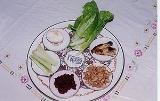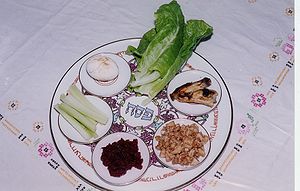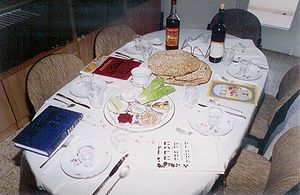
Passover Seder Plate
Encyclopedia

Hebrew language
Hebrew is a Semitic language of the Afroasiatic language family. Culturally, is it considered by Jews and other religious groups as the language of the Jewish people, though other Jewish languages had originated among diaspora Jews, and the Hebrew language is also used by non-Jewish groups, such...
: ke'ara (קערה) is a special plate
Plate (dishware)
A plate is a broad, concave, but mainly flat vessel on which food can be served. A plate can also be used for ceremonial or decorative purposes.-Materials:...
containing symbolic foods eaten or displayed at the Passover Seder
Passover Seder
The Passover Seder is a Jewish ritual feast that marks the beginning of the Jewish holiday of Passover. It is conducted on the evenings of the 14th day of Nisan in the Hebrew calendar, and on the 15th by traditionally observant Jews living outside Israel. This corresponds to late March or April in...
.
Significance
Each of the six items arranged on the plate has special significance to the retelling of the story of the exodusThe Exodus
The Exodus is the story of the departure of the Israelites from ancient Egypt described in the Hebrew Bible.Narrowly defined, the term refers only to the departure from Egypt described in the Book of Exodus; more widely, it takes in the subsequent law-givings and wanderings in the wilderness...
from Egypt
Ancient Egypt
Ancient Egypt was an ancient civilization of Northeastern Africa, concentrated along the lower reaches of the Nile River in what is now the modern country of Egypt. Egyptian civilization coalesced around 3150 BC with the political unification of Upper and Lower Egypt under the first pharaoh...
, which is the focus of this ritual meal. The seventh symbolic item used during the meal — a stack of three matzos — is placed on its own plate on the Seder table.
Symbolic foods
The six traditional items on the Seder Plate are as follows:- MarorMarorMaror also Marror, refers to the bitter herbs eaten at the Passover Seder in keeping with the biblical commandment "with bitter herbs they shall eat it." .-Biblical source:...
and chazeret — Bitter herbs, symbolizing the bitterness and harshness of the slavery which the Jews endured in EgyptAncient EgyptAncient Egypt was an ancient civilization of Northeastern Africa, concentrated along the lower reaches of the Nile River in what is now the modern country of Egypt. Egyptian civilization coalesced around 3150 BC with the political unification of Upper and Lower Egypt under the first pharaoh...
. Either horseradishHorseradishHorseradish is a perennial plant of the Brassicaceae family, which also includes mustard, wasabi, broccoli, and cabbages. The plant is probably native to south eastern Europe and the Arab World , but is popular around the world today...
or romaine lettuce may be eaten in fulfillment of the mitzvahMitzvahThe primary meaning of the Hebrew word refers to precepts and commandments as commanded by God...
of eating bitter herbs during the Seder.
- CharosetCharosetCharoset, haroset, or charoses is a sweet, dark-colored, chunky paste made of fruits and nuts served primarily during the Passover Seder. Its color and texture are meant to recall the mortar with which the Israelites bonded bricks when they were enslaved in Ancient Egypt as mentioned in Tractate...
— A sweet, brown mixture representing the mortar used by the Jewish slaves to build the storehouses of EgyptAncient EgyptAncient Egypt was an ancient civilization of Northeastern Africa, concentrated along the lower reaches of the Nile River in what is now the modern country of Egypt. Egyptian civilization coalesced around 3150 BC with the political unification of Upper and Lower Egypt under the first pharaoh...
. In Ashkenazi Jewish homes, charoset is traditionally made from chopped nuts, grated apples, cinnamon, and sweet red wine. Sephardi recipes call for dates and honey in addition to chopped nuts, cinnamon, and wine.
- KarpasKarpasKarpas is one of the traditional rituals in the Passover Seder. It refers to the vegetable, usually parsley or celery, that is dipped in liquid and eaten. The liquid may be any of the seven which make food capable of becoming ritually impure, although salt-water or vinegar are usually used...
— A vegetable other than bitter herbs, which is dipped into salt water at the beginning of the Seder. ParsleyParsleyParsley is a species of Petroselinum in the family Apiaceae, native to the central Mediterranean region , naturalized elsewhere in Europe, and widely cultivated as an herb, a spice and a vegetable.- Description :Garden parsley is a bright green hairless biennial herbaceous plant in temperate...
, celeryCeleryApium graveolens is a plant species in the family Apiaceae commonly known as celery or celeriac , depending on whether the petioles or roots are eaten: celery refers to the former and celeriac to the latter. Apium graveolens grows to 1 m tall...
or boiled potato is usually used. The dipping of a simple vegetable into salt water (which represents tears) mirrors the pain felt by the Jewish slaves in Egypt. Usually in a ShabbatShabbatShabbat is the seventh day of the Jewish week and a day of rest in Judaism. Shabbat is observed from a few minutes before sunset on Friday evening until a few minutes after when one would expect to be able to see three stars in the sky on Saturday night. The exact times, therefore, differ from...
or holidayJewish holidayJewish holidays are days observed by Jews as holy or secular commemorations of important events in Jewish history. In Hebrew, Jewish holidays and festivals, depending on their nature, may be called yom tov or chag or ta'anit...
meal, the first thing to be eaten after the kiddushKiddushKiddush , literally, "sanctification," is a blessing recited over wine or grape juice to sanctify the Shabbat and Jewish holidays.-Significance:...
over wine is bread. At the Seder table, however, the first thing to be eaten after the kiddush is a vegetable. This leads immediately to the recital of the famous question, Ma Nishtana — "Why is this night different from all other nights?" It also symbolizes the spring time, because Jews celebrate Passover in the spring.
- Z'roa — Also called Zeroah, it is special as it is the only element of meat on the Seder Plate. A roasted lamb or goat shankboneTibiaThe tibia , shinbone, or shankbone is the larger and stronger of the two bones in the leg below the knee in vertebrates , and connects the knee with the ankle bones....
, chicken wing, or chicken neck; symbolizing the korban Pesach (Pesach sacrifice), which was a lamb that was offered in the Temple in JerusalemTemple in JerusalemThe Temple in Jerusalem or Holy Temple , refers to one of a series of structures which were historically located on the Temple Mount in the Old City of Jerusalem, the current site of the Dome of the Rock. Historically, these successive temples stood at this location and functioned as the centre of...
, then roasted and eaten as part of the meal on Seder night. Since the destruction of the Temple, the z'roa serves as a visual reminder of the Pesach sacrifice; it is not eaten or handled during the Seder. Vegetarians often substitute a beetBeetThe beet is a plant in the Chenopodiaceae family which is now included in Amaranthaceae family. It is best known in its numerous cultivated varieties, the most well known of which is the purple root vegetable known as the beetroot or garden beet...
, quoting Pesachim 114b as justification.
- BeitzahEgg (food)Eggs are laid by females of many different species, including birds, reptiles, amphibians, and fish, and have probably been eaten by mankind for millennia. Bird and reptile eggs consist of a protective eggshell, albumen , and vitellus , contained within various thin membranes...
— A hard-boiled egg, symbolizing the korban chagigah (festival sacrifice) that was offered in the Temple in JerusalemTemple in JerusalemThe Temple in Jerusalem or Holy Temple , refers to one of a series of structures which were historically located on the Temple Mount in the Old City of Jerusalem, the current site of the Dome of the Rock. Historically, these successive temples stood at this location and functioned as the centre of...
and roasted and eaten as part of the meal on Seder night. Although both the Pesach sacrifice and the chagigah were meat offerings, the chagigah is commemorated by an egg, a symbol of mourning (as eggs are the first thing served to mourners after a funeral), evoking the idea of mourning over the destruction of the Temple and our inability to offer any kind of sacrifices in honor of the Pesach holiday. Since the destruction of the Temple, the beitzah serves as a visual reminder of the chagigah; it is not used during the formal part of the seder, but some people eat it with saltwater as the first course of the meal.
Many decorative and artistic Seder Plates sold in Judaica stores have pre-formed spaces for inserting the various symbolic foods.

Matzo
Matzo or matzah is an unleavened bread traditionally eaten by Jews during the week-long Passover holiday, when eating chametz—bread and other food which is made with leavened grain—is forbidden according to Jewish law. Currently, the most ubiquitous type of Matzo is the traditional Ashkenazic...
t, which are stacked and separated from each other by cloths or napkins. The middle matzah will be broken and half of it put aside for the afikoman
Afikoman
Afikoman is a half-piece of matzo which is broken in the early stages of the Passover Seder and set aside to be eaten as a dessert after the meal.Based on the Mishnah in Pesahim 119a, the afikoman is a substitute for the Korban Pesach, which was...
. The top and other half of the middle matzot will be used for the hamotzi (blessing over bread), and the bottom matzah will be used for the korech (Hillel sandwich).
A bowl of salt water, which is used for the first "dipping" of the Seder, is not traditionally part of the Seder Plate, but is placed on the table beside it. However, it sometimes is used as one of the six items, omitting chazeret. It is sometimes placed in the center of the plate.
Variants
- OrangeOrange (fruit)An orange—specifically, the sweet orange—is the citrus Citrus × sinensis and its fruit. It is the most commonly grown tree fruit in the world....
. — Since the early 1980s, a custom has arisen (especially among more liberal and feminist Jews) to include an orangeOrange (fruit)An orange—specifically, the sweet orange—is the citrus Citrus × sinensis and its fruit. It is the most commonly grown tree fruit in the world....
on the Seder plate. This custom is often explained as having arisen in response to a man who confronted a Jewish feministJewish feminismJewish feminism is a movement that seeks to improve the religious, legal, and social status of women within Judaism and to open up new opportunities for religious experience and leadership for Jewish women...
who was giving a speech and opposed the right of women to become rabbis, supposedly declaring that women had as much place on the bimahBimahA bimah A bimah A bimah (among Ashkenazim, derived from Hebrew בּמה , almemar (from Arabic al-minbar) or tebah (among Sephardim) is the elevated area or platform in a Jewish synagogue which is intended to serve the place where the person reading aloud from the Torah stands during the Torah reading...
as an orange had on the seder plate. However, Susannah Heschel, a Jewish scholar who is widely credited with beginning this custom, has explained it as a symbol of the fruitfulness of all Jews, including gay men and lesbians. After hearing that some college students were placing crusts of bread on their seder plates as a protest against the exclusion of homosexuals from Judaism, Heschel substituted the fruit (originally a tangerineTangerine__notoc__The tangerine is an orange-colored citrus fruit which is closely related to the Mandarin orange . Taxonomically, it should probably be formally named as a subspecies or variety of Citrus reticulata; further work seems to be required to ascertain its correct scientific name...
) on the plate instead. Today, there are seder plates made with seven spots, an extra for the orange on the seder plate, such as Michael Aram's Pomegranate Seder Plate.

